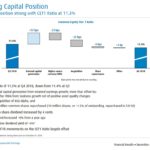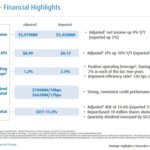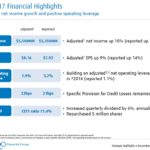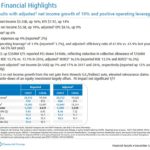Contents
 Summary
Summary
- BMO recently reported FY2018 which reflected the benefit of a 21% YoY reduction in the provisions for credit losses as well as a low tax rate.
- Canadian and US operations benefited from solid loan growth with strong Q4 performance evidenced in Personal and Commercial banking and accelerated growth in its U.S. segment.
- Senior management is confident it can continue to deliver adjusted EPS growth within the 7% - 10% medium-term target range. I am erring on the side of caution and am projecting 7% adjusted EPS growth for FY2019.
- In my September 5th article I viewed BMO as somewhat expensive. Based on the subsequent ~11.3% stock price pullback and my FY2019 earnings projections I now view BMO as fairly valued.
All figures are expressed in CDN $ unless otherwise noted.
Introduction
This fifth article in this series covering the Big 5 Schedule A Canadian banks touches upon The Bank of Montreal (TSX: BMO); BMO released its Q4 and FY2018 earnings on December 4.
Article 1 covered The Bank of Nova Scotia (TSX: BNS), article 2 covered The Royal Bank of Canada (TSX: RY), article 3 covered The Toronto-Dominion Bank (TSX: TD), and the article 4 covered The Canadian Imperial Bank of Commerce (TSX: CM).
Please refer to article 2 in which I cover Canada’s FI landscape.
I am satisfied with my level of exposure to BNS, RY, and TD. I have, however, been of the opinion for quite some time that I could further boost my exposure to CM and BMO.
I have been reluctant to acquire additional BMO and CM shares and in my September 5th article I indicated that because of various headwinds / uncertainties I would refrain from acquiring additional shares in any of the Big 5 other than through the automatic reinvestment of all dividends. In hindsight, this has worked out well since the share prices of the Big 5 have retraced; BMO’s share price has retraced ~11.3% subsequent to that article.
As luck would have it, investors have not been reacting kindly to the news surrounding U.S.-China trade and the falling 10-year yield has also spooked investors. This has resulted in share prices, in general, taking a hit on December 4th.
Quite frankly, I wish share prices would plunge further but now that CM’s and BMO’s share prices have retraced to levels I view as attractive from a long-term perspective, I have taken the opportunity to acquire 500 CM shares and 500 BMO shares today for the ‘Side Accounts’ within the FFJ Portfolio; these purchases will generate between CDN $4700 - $5000 in additional dividend income in 2019. As a result, the projected CDN $12,000 dividend income for 2019 which I expect to generate through the ‘Side’ accounts (see recent FFJ Portfolio update) will need to be revised upwards. My intent is to more closely analyze the projected dividend income for 2019 through the ‘Core’ and ‘Side’ accounts before I publish my December 2018 FFJ Portfolio update.
I have absolutely no idea whether share prices will rise or fall in the near term. I do, however, think that over the long-term share prices will rise. This is why I try to acquire shares when I think a company’s shares are fairly valued. Furthermore, I place more emphasis on generating a relatively safe and increasing stream of dividend income because selling shares to generate income during retirement is not a priority.
Q4 and FY2018 Results
BMO’s Earnings Release can be found here and its detailed investor presentation can be found here.
BMO’s Q4 2018 Investor fact Sheet can be found here.
Source: BMO – Q4 and FY2018 Financial Results – December 4, 2018
I provide BMO’s Fiscal 2017 Highlights for ease of comparison.
Source: BMO – Q4 and FY2017 Financial Results – December 5, 2017
FY2019 Outlook
On the December 4th conference call with analysts BMO indicated that delinquency and loss rates for the Canadian residential portfolio in the mortgage space remained stable.
Given the weakness in the energy sector analysts were interested in learning more about BMO’s exposure to this space. BMO was quick to point out that its energy portfolio represents approximately 2% of total loans and the portfolio is well diversified by geography; almost 50% of energy-related outstandings is from outside Canada. Canadian exploration and development only constitutes 29% of the bank’s energy exposure and ~75% is investment grade.
BMO drilled down further into its energy sector exposure and indicated that companies with a thinner energy portfolio that have any exposure to Western Canada Select is only 15% of BMO’s total energy exposure and only 0.4% of total loans. In addition, more than 75% are currently investment grade within this segment.
BMO is forecasting a generally conducive business environment but it does see the prospect for modestly higher provisions over 2019. There are no specific issues in any of BMO’s portfolios but overall loss experience in FY2018 was at the low end of the historic range. As a result, BMO expects slightly higher loan loss levels in FY2019.
Credit Ratings and Common Equity Tier 1 (CET1) Ratio
BMO's current ratings and outlook from Moody’s, S&P Global, Fitch, and DBRS meet my risk tolerance level.
 Source: BMO – Q4 and FY2018 Financial Results – December 4 2018
Source: BMO – Q4 and FY2018 Financial Results – December 4 2018
The Risk Review component of BMO’s Q4 Investor Presentation found on pages 16 - 20 provides an overview of the risk aspect of the bank’s various credit related lines of business.
Valuation
BMO reported diluted EPS of $8.17 and adjusted diluted EPS of $8.99 versus $7.92 and $8.16 in FY2017. This represents diluted EPS growth of ~3.16% and adjusted diluted EPS growth of ~10.2%.
When BMO reported FY2017 diluted EPS of $7.92 on December 5, 2017, its share price closed at $99.14 giving us a diluted PE of ~12.52.
BMO’s 1, 5, and 10 year PE is 12.1, 12.2, and 12.4; the 1-year measure is as at October 31, 2018 while the 5-year and 10-year measures are the average of year-end values. BMO is currently trading at ~$95.19 so using FY2018’s diluted EPS of $8.17, BMO’s PE is currently ~11.65.
BMO’s 1, 5, and 10 year Average growth in annual adjusted EPS is 10.1%, 7.7%, and 7.1%; BMO’s adjusted EPS target growth range is 7% - 10%.
I am of the opinion there are sufficient headwinds that it is prudent to use the low end of the target range to estimate FY2019 adjusted EPS. If I take FY2018’s $8.99 and increase this by 7% then I anticipate BMO will generate ~$9.62 in adjusted EPS in FY2019. Using this projection and BMO’s current ~95.19 stock price I arrive at a forward adjusted PE of ~9.9.
In my opinion, BMO is currently attractively valued.
Dividends
BMO distributed its second $0.96/share quarterly dividend on November 27th.
BMO’s dividend history can be found here and additional information can be found here.
In keeping with the bank’s practice of increasing its quarterly dividend after two consecutive dividend payments of equal value BMO announced on December 4th that its quarterly dividend was being increased to $1.00/share. This $0.04/share increase is a ~4.17% increase from its recently distributed $0.96/share quarterly dividend.
I will err on the side of caution in predicting BMO’s 2019 total dividend distribution. I envision two quarterly payments of $1.00/share and a $0.03/share increase for the 3rd and 4th dividend payments. On this basis BMO’s annual dividend will likely be $4.06 ((2 x $1.00) = (2 x $1.03)); BMO’s 2018 dividend distribution was $3.78. This represents a ~7.4% increase in BMO’s annual dividend from 2018’s level.
Stock screeners currently reflect an annual dividend yield of ~3.9%. Using my dividend projection and the current ~$95.19 stock price I get a forward dividend yield of ~4.27%.
Final Thoughts
I fully recognize that economic growth is highly likely to slow in North America and global economic uncertainty and trade tensions (ie. U.S.-China trade war and strains in the energy and automotive manufacturing sectors) could negatively impact the performance of the Big 5 Canadian banks. I, however, do not invest for the short-term and am reasonably confident that in 10 – 20 years the companies in which I invest will be far more valuable than today. My focus is to identify fairly valued companies that will provide a reasonably safe and growing stream of dividend income (income growth that outpaces the rate of inflation) that will allow you/me to service our future obligations.
In my opinion, the Big 5 Schedule A Canadian banks are ideal companies for my ‘watching paint dry’ investment approach.
I hope you enjoyed this post and I wish you much success on your journey to financial freedom.
Thanks for reading!
Note: I sincerely appreciate the time you took to read this article. Please send any feedback, corrections, or questions to [email protected].
Disclaimer: I have no knowledge of your individual circumstances and am not providing individualized advice or recommendations. I encourage you not to make any investment decision without conducting your own research and due diligence. You should also consult your financial advisor about your specific situation.
Disclosure: I am long BMO, BNS, CM, RY, and TD.
I wrote this article myself and it expresses my own opinions. I am not receiving compensation for it and have no business relationship with any company whose stock is mentioned in this article.





